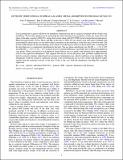OUTFLOW VERSUS INFALL IN SPIRAL GALAXIES: METAL ABSORPTION IN THE HALO OF NGC 891
Author(s)
Bregman, Joel N.; Seitzer, Patrick; Cowley, C. R.; Miller, Matthew J.; Miller, Eric D
DownloadBregman-2013-OUTFLOW VERSUS INFAL.pdf (551.3Kb)
PUBLISHER_POLICY
Publisher Policy
Article is made available in accordance with the publisher's policy and may be subject to US copyright law. Please refer to the publisher's site for terms of use.
Terms of use
Metadata
Show full item recordAbstract
Gas accreting onto a galaxy will be of low metallicity while halo gas due to a galactic fountain will be of near-solar metallicity. We test these predictions by measuring the metal absorption line properties of halo gas 5 kpc above the plane of the edge-on galaxy NGC 891, using observations taken with HST/STIS toward a bright background quasar. Metal absorption lines of Fe II, Mg II, and Mg I in the halo of NGC 891 are clearly seen, and when combined with recent deep H I observations, we are able to place constraints on the metallicity of the halo gas for the first time. The H I line width defines the line broadening, from which we model opacity effects in these metal lines, assuming that the absorbing gas is continuously distributed in the halo. The gas-phase metallicities are [Fe/H] = –1.18 ± 0.07 and [Mg/H] = –0.23 + 0.36/ – 0.27 (statistical errors) and this difference is probably due to differential depletion onto grains. When corrected for such depletion using Galactic gas as a guide, both elements have approximately solar or even supersolar abundances. This suggests that the gas is from the galaxy disk, probably expelled into the halo by a galactic fountain, rather than from accretion of intergalactic gas, which would have a low metallicity. The abundances would be raised by significant amounts if the absorbing gas lies in a few clouds with thermal widths smaller than the rotational velocity of the halo. If this is the case, both the abundances and [Mg/Fe] would be supersolar.
Date issued
2013-03Department
MIT Kavli Institute for Astrophysics and Space ResearchJournal
The Astrophysical Journal
Publisher
IOP Publishing
Citation
Bregman, Joel N., Eric D. Miller, Patrick Seitzer, C. R. Cowley, and Matthew J. Miller. “OUTFLOW VERSUS INFALL IN SPIRAL GALAXIES: METAL ABSORPTION IN THE HALO OF NGC 891.” The Astrophysical Journal 766, no. 1 (March 7, 2013): 57. © 2013 The American Astronomical Society
Version: Final published version
ISSN
0004-637X
1538-4357